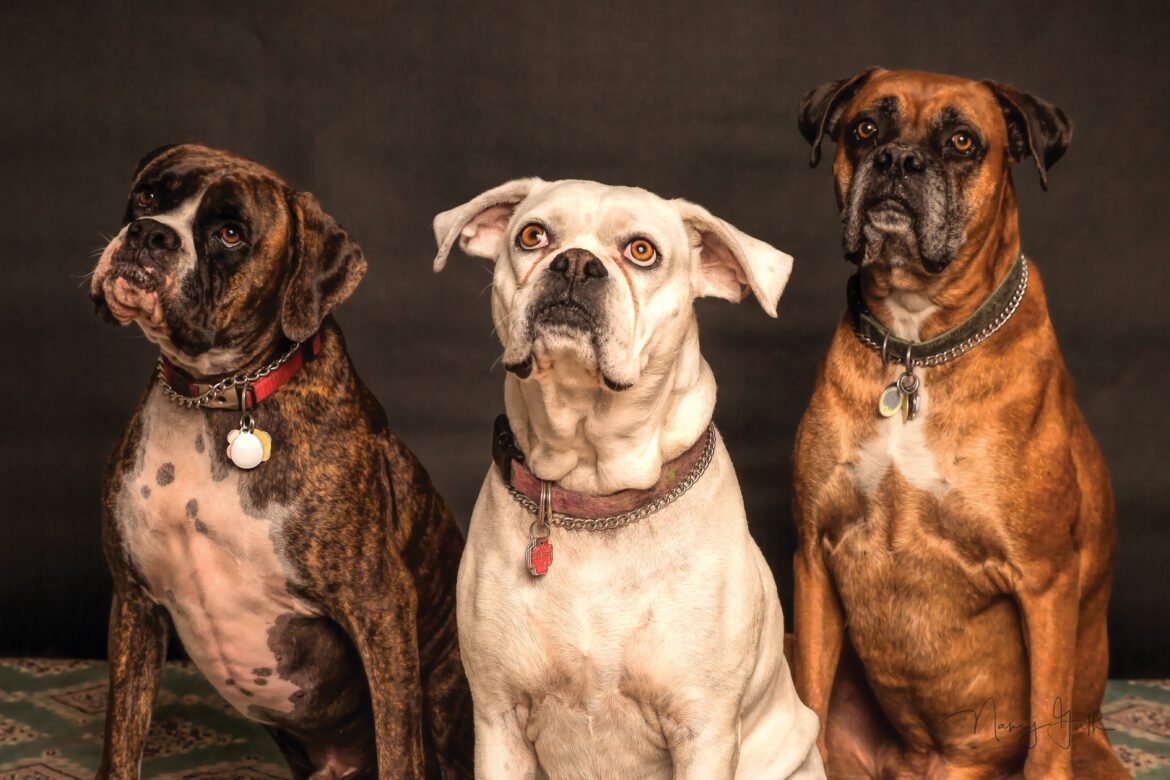Introduction
Stories of a dog’s unwavering loyalty have been passed down through the decades in India, appearing everywhere from the Mahabharata to folklore. Similarly to other cultures, Indians hold canines in high regard for their loyalty and the way they defend their human friends.
Despite being better suited to the Indian climate and way of life, Indian dog breeds are often overlooked. Here is a list of some of India’s most popular dog breeds if you’re thinking about bringing one home.
Kombai/Combai (Indian Terrier)
The Combai is one of the native Indian dog breeds found in the foothills of the Western Ghats. Indian Terrier is another name for this ancient breed. It was nearly extinct, but dog lovers and supporters in Tamil Nadu helped bring it back from the brink.
Both aggression and loyalty are hallmarks of this breed. It’s a healthy dog breed that originates in India. Historic aristocrats used it for hunting wild boar, deer, bison, etc. This breed is patient and kind to young members of the household. These dog breeds resemble Indian pariah dogs.
It has a bulky build, with a black mask covering its ears, eyes, and mouth. It has strong jaws, long, powerful legs, a sturdy shoulder, and a broad, muscular neck, making it an ideal hunter. Tan, red, brown, and other tonalities are all possible. It has a long, feathered tail that is usually coiled and held high. Its short, straight, and dense coat are typical for the breed.

The Dhangri or Maharashtrian Shepherd Dog
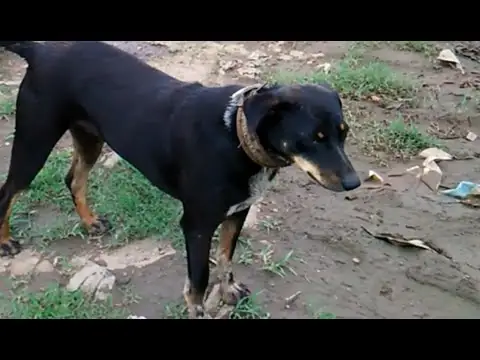 The Korku tribes of Maharashtra formed this dog by mixing the native Pariah dog with native hounds (the Kakadi Hound and the Caravan Hound) to herd sheep and goats. This canine is considered an unusual livestock guardian dog of the Korku tribes of Western India.
The Korku tribes of Maharashtra formed this dog by mixing the native Pariah dog with native hounds (the Kakadi Hound and the Caravan Hound) to herd sheep and goats. This canine is considered an unusual livestock guardian dog of the Korku tribes of Western India.
Originally bred for protection, modern Maharashtrian Shepherds are also effective herders and hunters thanks to their smartness and size.
Dhangaris are slim, skinny canines like Greyhounds and are very intelligent and loyal—they are fierce and powerful and best suited for rural situations.
The Alangu Mastiff
Historically, wartime situations called for the usage of the Alangu Mastiff, also known as the Sindh Mastiff, due to the dog’s size, strength, and agility. They have an impeccable reputation for their keen sense of smell and formidable guarding abilities.
Erect ears and strong, broad, black muzzles are distinguishing features of Alangu. Because of their strength, stamina, and lack of timidity, they are frequently employed in dogfighting and as guard dogs.
Incredibly loyal and protective of their master, they will do anything to ensure his safety. This is because they can be dominating and aggressive, making them unsuitable for first-time pet owners.
The Bahawalpur region of Punjab, along with some regions of Rajasthan and the arid region of Kutch, is the likely cradle of the Alangu Mastiff.
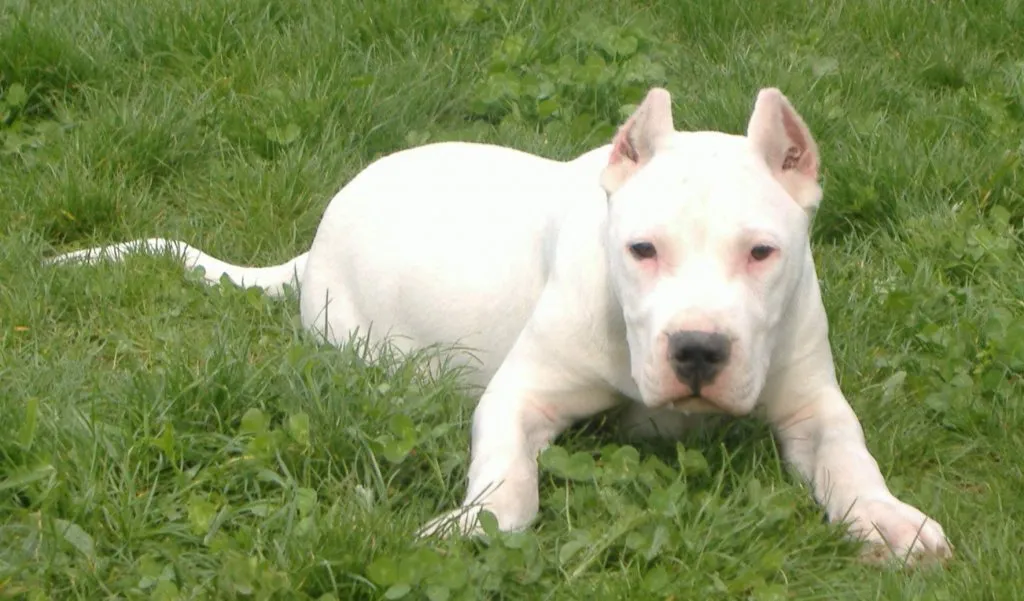
Kashmiri sheepdog

The Gujjars, a Muslim nomadic people, developed the Kashmiri Sheepdog (also known as the Bakharwal Sheepdog) to guard their flocks against wolves and bears. The breed originates in the Himalayas, specifically the Pir Panjal mountain region in the Kashmir Himalayas. This breed is also known as the Kashmiri Sheepdog since it was traditionally used for herding sheep and goats in the Kashmir region of India.
Because of its origins in defense of goats and sheep from the wolves and bears of the Himalayas, the dog is commonly known as a Bakharawal, a term derived from the word Bakri, meaning goat. Different names for this dog include the Gujjar Watchdog, Bakharwal, Gujjar
Dog, and Kashmiri Mastiff. Photo courtesy -Gurinder Partap Singh Basra
No major kennel association recognizes this breed, and the IUCN lists it as endangered.
Kanni
South India is home to the rare dog breed known as the Kanni. It might remind you of Greyhound. The Maiden’s Beastmaster is a term used to describe this dog in South India, where it is mostly employed for the coursing game.
Kanni, which is used to refer to this breed, means “pure” in Tamil. The Kanni is prized for its fidelity and good nature, which are also reasons for its name.
Cream, black, brown, tan, and brindle are among its five most common colors. The Kanni moniker is reserved for the black-and-tan variation of the breed; the Chippiparai label is used for the others. In the past, people employed it to capture hares, blackbucks, rabbits, and other small game.
Cheetah-like in its straight, long-muzzled head, lean, catlike legs, and broad chest. Slim and muscular, with a supple spine. One has excellent hearing, smell, and eyesight.
In addition, while pursuing a target, it may reach speeds of up to 60 kilometers per hour. Thanks to its short coat, it requires less maintenance in terms of brushing and shedding.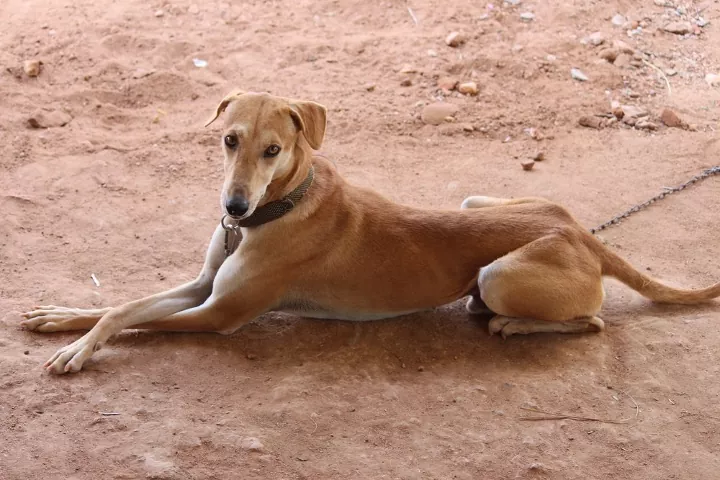
Bakharwal Dogs
A variety of names, including the Kashmir Sheepdog, Kashmir Mastiff, Gujjar Watchdog, and many others knows large canines native to India. They are Bakharwal Dogs, but we’ll stick with that name for simplicity’s sake.
There is no need to mess with these canines. Strong and agile, these dogs have a lot of muscle mass to their build.
The Barkharwal is a breed of working dog that was established in Jammu and Kashmir by the Bakarwal and Gujjar people. Despite being bred primarily as livestock guardians, these canines were useful in every aspect of village life.
According to Indian legend, the ancient Barkharwal was developed from a wolf and Molosser sheepdog hybrid that first appeared many generations ago. The Indian dog breed is endangered nowadays.

Soriala Greyhound or Bengal Hound (Sarail Hound in Bangladesh)
As an Indian dog breed of sighthounds, the Soriala Greyhound can be found in its home state of West Bengal, India. Sarail Hounds is another name for them in Bangladesh, whereas Bengal Hounds is used in West Bengal, India.
The Rampur Hound, native to the city of Rampur between Delhi and Bareilly in northern India, is a close relative of this breed.
The ancestry of Soriala Hounds includes some very muscular, athletic dogs with powerful jaws and a broad, sturdy cranium. The Soriala are formidable hunters who can take down bulls, rodents, deer, and jackals. The number of Sorialas is so low that they may soon become extinct.

Image Credit- cdn.ebaumsworld.com
Jonangi
Originally from the Indian state of Andhra Pradesh, the Jonangi dog is known for being hypoallergenic. However, these dogs were specifically bred to herd ducks for local farmers, making them unique among Indian hunting dogs. Wow, that’s a really neat mix, right?
The Jonangi, however, only enjoyed brief periods of fame. At some point, farmers in the region of Kolleru Lake stopped focusing on duck hunting in favor of pursuing other, more lucrative aquatic animals. This meant that the once-in-demand Jonangi was suddenly redundant.
Farmers gave up on them and left them to fend for themselves in the wilderness. Unfortunately, these canines’ survival required them to master excellent fishing skills. The local fish farmers began seeing them as a nuisance, which prompted a massacre. Yodeling is the sound made by the Jonangi dog instead of barking.

Gaddi Kutta (Dog)
Northern India is the home of the Gaddi Kutta, a kind of mountain dog. States like Himachal and Pradesh, which border the Himalayas, are home to these people. This makes the Gaddi Kutta a mastiff-type dog like the Tibetan Mastiff. They receive their nickname “Indian Panther Hound” because of their ability to take down a single snow leopard.
The Gaddi is also known as the Mahidant Mastiff and the Indian Panther Hound. Both of which seem to meet the bill. But what makes them remarkable dogs is their number of skills employed for numerous professions. Protective functions are not their exclusive function.
Gaddi Kuttas are able to hunt wildlife, herd sheep (and goats), and protect livestock from even the most ferocious and dangerous predators, like snow leopards. The Gaddis of India uses these canines as general-purpose mastiffs.

The Himalayan Mastiff
The Indigenous Mastiff and the Himalayan Mastiff are two more names for these Indian dog breeds. Himalayan Mastiffs are taller and more muscular than their Tibetan counterparts. Though they share a lot of physical characteristics with Tibetan Mastiffs, their personalities and behaviors are quite distinct.
Dogs of the Himalayan breed are known for their calm demeanor and eagerness to please their master. They prefer to be alone and aren’t fond of canine companions. Rumor has it that a mature male Himalayan Mastiff can easily kill two wolves. This dog is now listed as a threatened species.

The Tazi or Tajik
India is the birthplace of the Taji, also known as the Tazi. They were developed to be effective hunting companions, able to track and kill various game, including fox, gazelle, wildcat, and marmot. Since there are so few Taji dogs left, data on them is scarce.
But we know they’re nearly extinct, and finding a purebred Taji anywhere in India is tough. The Russian Taji (tazi) dog most closely resembles this type. The Russian version is typically larger and has more fur on the coat.

Indian Spitz Dog
These Indian dog breeds, the Indian Spitz Dogs are classified as Utility Dosg. After breeding from a line of German Spitzes, the British brought the Indian Spitz to India. It thrives in the hot, humid conditions of the Indian plains, where it was originally from. It shares a lot of visual similarities with Samoyeds and German Spitz.
Vivacious and adaptable, the Indian Spitz dog thrives in a wide range of environments and can take to a variety of diets. It gets along well with people and other dogs in the family, but it also makes a great watchdog because it barks at strangers.
It has short legs in relation to its body length and a small, triangular head. The coat is dense and long, with hairs of varying colors (white, black, brown, etc.). The tail has a habit of snaking over the back.
There are two sizes of Indian Spitz: the tiny small Indian Spitz and the larger greater Indian Spitz.

Rajapalayam dog
The Rajapalayam is an Indian sighthound that hails from the southern part of the country and is also known as the Poligar Hound. The Chola empire of India bred these dogs to be versatile guardians and workers.
In the past, only the affluent residents of Rajapalayam, Tamil Nadu’s royal capital, could afford to keep Rajapalayam dogs as pets. As a result of its cultural significance in India, the India Post has highlighted this breed on postal stamps.
During the Carnatic Wars and Polygar Wars, Rajapalayams were bred specifically for use as war dogs against the British. The Indian military still uses the Rajapalayam, and they may often be found along the Kashmir border. According to some scholars, the Rajapalayam may have been the ancestor of the Dalmatian dog.

Mudhol Hounds
For centuries, these enormous and medium-sized canines have been used as guard dogs and hunting companions. Indeed, in the rural areas of the Deccan Plateau, these animals are frequent household pets. A small number of Mudhols also serve in the Indian armed forces.
Although its exact ancestry is unknown, these dogs likely arrived in the Americas with Asian immigrants. They’ve been shaped into something uniquely Indian ever since.

Rampur Greyhound
Rampur Greyhound is native to the Rampur region near Delhi to Bareilly in North Delhi. The name is inspired by its origin, Rampur. Earlier, these breeds were created by the king’s descendants of Rampur.
The dog looks like Greyhound. So, it’s called North American Greyhound. It was widely used in the upper classes to catch jackals and wild boars. These Indian dog breeds are tall and athletic and have large legs, narrow bodies and snout-shaped tails. The coat can be long and thin and has a wide variety of shades: Black, White, Gray, Tan brindled and others.

The Kaikadi Dog
Kaikadi dogs were named after the nomadic tribes in Maharashtra. The kaikadi was bred in India as an adult breed that was mixed with stray dogs. This Indian dog breed is alert, athletic, and an excellent livestock guardian dog with similar qualities to Whippet.
It’s possible to choose between white or dark colors, and their main colors are red, tan or black. This breed is small in size (around 40 cm in height) and short with long legs but strong legs and hips. They have long tail that has tapered head, and their head is narrow.
Despite being bred for herding purposes initially, these dogs have also found success in hunting. Hare, foxes, rodents, and other pests are the primary prey for Kaikadi dogs.
Their distinctive traits include long, narrow legs and a thin, long tail. In addition, the skull is long and slender, and the ears are similarly elongated and pointed. The short hair of the Kaikadi dog breed makes it easy to keep it clean and well-groomed.

Bully Kutta (dog)/ Indian Mastiff
Bullied Kutta is native to India. Its famous names are such as the Indian Mastiffs, Alangu Mastiffs, and Pakistani Bully Kutta. These dog breeds distinguish themselves in wrinkled skin and thick and tough muscle. Its popular name is called “The Beast from the Eastern.”
As awful as it is, they are also put to use in battle alongside their more peaceful hunting and guarding roles. In some parts of Pakistan and Punjab, India, these dogs are still used in illegal dog fighting. Of course, when you consider that an adult Bully Kutta may weigh in at over 100 pounds and stand over 3 feet tall, you can see why.
This is a popular Indian dog breed in Punjab and is not in danger of going the way of the dodo. The Bully Kutta has ironically survived because of its popularity in illegal dog fighting. Nonetheless, we can’t predict how long this will continue.

Pandikona
Pandikona, the Indian dog breed, is found in the Kurnool district of Andhra Pradesh and Madhya Pradesh. It has an excellent adapted climate of Kurnool and is an early-type hunting dog species at risk of extinction.
They primarily pursue rodents and small mammals like pigs, rabbits, and hares. On the other hand, they are notorious for eliminating pests like rats, mice, and snakes that are a nuisance around the hamlet. Because of this behavior, communities welcome and encourage their presence.
Domesticated Pandikona are frequently utilized as security dogs due to their ferocious territorial nature. They serve as village guards, keeping property and cattle safe. If you happen upon a Pandikona, he will most likely provide a few terse warnings before launching a devastating attack.

Gull Terrier
The Gully Terriers, also called Gull Terriers, are rare Indian dog breeds. This breed is most commonly used to hunt, protect, and fight. It resembles the bulldog breed of the British.
British settlers breed it during their reign in India and Pakistan. It also interbred with local dog breeders to produce a breed that specialized in dogs fighting bears in their habitats. Gull terriers are smart dogs that are trained quickly. Occasionally, they will fight in the last moment in defense against their owner.

Soneri Kutta
The dogs are native to Uttar Pradesh in India and the state of Bihar and they have been used to retrieve buffalos by farmers in India around Son River. These dogs can easily swim long and are very athletic and robust.
According to locals, Soneri Kupta is still unknown as its origin is unclear. When the British came to India, they had a number of dog races which were good swimmers. Soneri Kuttas are a mix of those dogs and Indian Prahran. Generally Soneri Kutta is black. Some have either a Red (fawn) or a Red White mix color.

Indian Pariah dog
Pariahs of India has often been called Desi dogs. India dogs or Pye dogs in south Asia. This is well known for its sociability and good behavior and adapts quickly to nature and culture. It enjoys interaction with others who are in their family. It is easily trained and is usually used for police or guard dogs.
It is a medium dog breed with erect ears, a wedged head and an erect tail usually hanging on and curling around its tip. Its coats are thick and are of various shades, including dark brown and yellow.

The Dhole or Asiatic/Indian Wild Dogs
The Indian Wild Dog is also called red dog – Red Fox Dog for its look like a red fox. It has an extremely similar physical structure to the Australian dog. However, dholes are similar to African Wild Dogs and are capable of taming prey up to ten-fold the size.
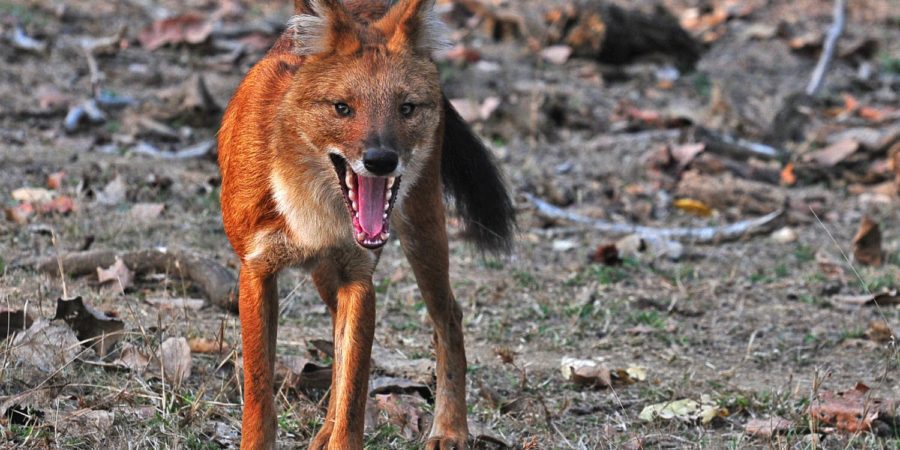
Tangkhul Hui
The Tangkhul Hui, also known as the Awang Huijao, was developed as a hunting dog in India’s dense forests, where it proved adept at killing wild boar and other dangerous game. Still, the Urkhul area of Manipur is where you’re most likely to encounter them.
Though now critically endangered, this dog breed is still present in their native land. The Tangkhul Hui may have descended from canines in Myanmar many generations ago, according to historians. They are thought to have descended from black bears in Asia, according to Indian legend.
This Indian urban legend most likely originated from the uncanny similarity between the two creatures’ noses. Although the Tangkhul Hui is in peril, many communities and animal rights activists in the Urkhul district are working together to save the species.

Mahratta Greyhound
Even in their home country of India, Mahratta Greyhounds remain a rare sight. Most of these dogs now live in the province of Maharashtra in western India, and sightings outside this region are quite unusual.
The smooth-coated Saluki is a common comparison for these dogs. On the other hand, Mahratta Greyhounds are slightly smaller, reaching a maximum height of about 21 inches. Like other sighthounds, Mahrattas are tough and well-built, having a muscular build and a narrow chest. No one knows where these dogs come from. Both Salukis and native Indian sighthounds have been proposed as possible ancestors.
No major kennel club currently recognizes the Mahratta Greyhound as a legitimate breed.
In terms of dog ancestry, these animals hail from India and are among the oldest alive today. They’re likely older than 5,000 years.
The dog’s short coat serves its purpose well, protecting it from the harsh conditions of the Indian countryside. Their skinny legs are deceptively strong, allowing them the speed and agility to outrun prey. They were excellent hunting dogs.

Vikhan Sheepdog
 Despite being an indigenous Indian dog breed, the Vikhan Sheepdog is largely unknown outside of the country. The Himachal Pradesh state in northern India is their place of origin. Nonetheless, despite their roots, Vikhans can also be found in neighboring parts of Pakistan.
Despite being an indigenous Indian dog breed, the Vikhan Sheepdog is largely unknown outside of the country. The Himachal Pradesh state in northern India is their place of origin. Nonetheless, despite their roots, Vikhans can also be found in neighboring parts of Pakistan.
Vikhans, like other sheepdogs, were originally developed to protect sheep and other livestock. However, they are skilled leopard hunters because of their lack of fear. For this reason, Vikhans bred for centuries and became multipurpose workers and hunting dogs.
Due to the fact that they are quite uncommon in India, however, we lack a wealth of data about these canines. Few people have heard of them; therefore, it’s impossible to say how close they are to extinction. Moreover, very few people are making any kind of preservation effort.
Kumaon Mastiff
The Kumaon Mastiff, also known as the Cypro Kukor, is an aggressive molosser Indian dog breed that was developed in India’s northernmost state of Uttarakhand. These guard dogs are among the most highly valued in India due to their strength and durability. Despite this, you won’t find many of these dogs around.
When first developed, the Kumaon Mastiff’s primary function was to serve as a livestock guardian for the people who lived on the region’s steep hills. The Kumaon Mastiff, like many other Indian dog breeds, faces extinction due to challenges with obedience training and socialization.
These Mastiffs are distinguished by their short, plush coats, which can be any shade of brown or brindle. They have the potential to reach a height of 28 inches (at the shoulder) and a weight of over 100 pounds. And they look eerily like the older, more hostile Great Danes of yesteryear.

Sinhala Hound
This dog’s ancestors can be traced back to Sri Lanka and various parts of India. The origin of these dog breeds is a mystery, and there is ongoing disagreement about where they first appeared. However, there are many who continue to argue that India is where it all began.
For instance, we know that Sinhalas resemble the Indian Pariah Dog. Therefore, researchers have hypothesized that the Sinhala people are of Indian landrace descent. Indeed, there isn’t yet rock-solid proof of this.
They share a name with the Indian Pariah Dog, but their personalities and abilities differ. It is thought that the Vedda people (an indigenous population of Sri Lanka) relied heavily on them for their hunting techniques.

Reasons for the extinction of Indian dog breed
If you haven’t heard, nearly half of India’s canine breeds have vanished. Even more, they are at imminent risk. It might stand out as peculiar in a nation where millions of canine companions roam the streets. What, then, is the cause of the extinction of Indian dog breeds?
One possible explanation for the rapid extinction of indigenous Indian dog breeds is that their culture has never fully adopted domestic breeds. While simultaneously welcoming exotic species. The Indian dog’s once-high popularity has steadily declined for several decades.
According to a Quartz article titled “The Indian dogs that are dying off because everyone wants a Labrador,” the severity of the problem is explained. In recent decades, western dog breeds have become increasingly popular in India.
It doesn’t help that they still discriminate against local dog breeds. Many different types of dogs were interbred with the introduction of exotic breeds. The authorities also showed no concern for the survival of native canine breeds.
Worse yet, foreign dog breeds were the favorites of Indian aristocrats who kept dogs as pets. Only British dog lovers made any effort to keep them alive. Unfortunately, many of these canines cannot be saved despite the efforts of various organizations in India.
